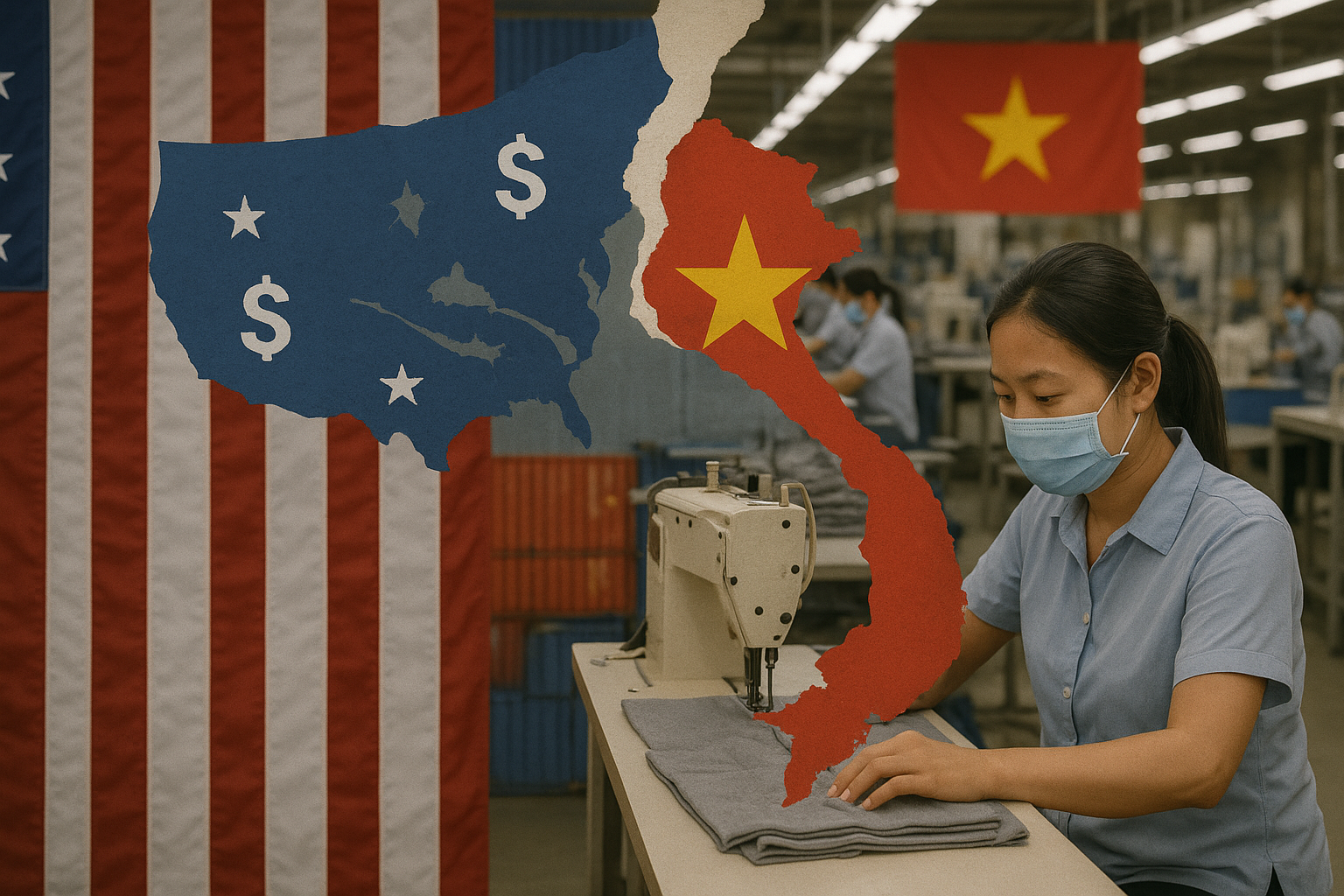Free Trade
How Trump's Tariff Threatens Vietnam’s Economy

Image generated by ChatGPT
U.S. President Donald Trump’s reciprocal tariffs has shaken not only global markets but also the international political stage with its sweeping and unilateral imposition of shockingly high tariffs, designed as initial pressure tactics to force negotiations. A baseline 10% tariff now applies until July (90 day-pause) to most countries that have not retaliated, excluding China. Due to its strong countermeasures, tariffs on Chinese goods (by the end of April 2025) have risen to 145%, comprising a 125% reciprocal tariff and an additional 20% imposed since February.
This action not only challenges the liberal international trade system that has taken over four decades to build, but also places nations in a reactive position, facing a potential global trade crisis. China responded swiftly with tough retaliatory measures. The European Union showed firmness but remained cautious, particularly Germany and France. Other countries, such as Japan, South Korea, and ASEAN members, including Vietnam, have opted for a more flexible and diplomatic path, prioritizing dialogue to prevent escalation.
Although the U.S. reciprocal tariff was officially presented as a response to America’s global trade deficit, it is evident that the policy is strategically aimed at curbing China’s economic influence, particularly through its deeply embedded supply chains in neighboring economies. Vietnam, which has benefited significantly from the relocation of production away from China in recent years, now finds itself increasingly entangled in this evolving U.S. trade strategy.
Vietnam Under Direct Pressure
A considerable share of Vietnam’s exports to the United States originates from China in the form of intermediate goods and components. In fact, the foreign value added (FVA) from China accounts for approximately 30% of Vietnam’s total exports to the U.S., the highest among ASEAN countries. This dependency is key sectors such as electronics and computers, garments, footwear, and wooden furniture, all of which are Vietnam’s major export categories to the U.S. As a result, Vietnam faces significant disadvantages in tariff negotiations with the U.S., particularly when the traceability of product origin becomes a central concern.
Given Vietnam’s export economy, the country is particularly vulnerable to the U.S. tariff hike. In 2024, exports to the United States amounted to 28.7% of Vietnam’s GDP, a figure that speaks for itself. The tentative imposition of a 46% tariff renders Vietnamese goods nearly uncompetitive in the American market, especially when compared to goods from Mexico, India, or Bangladesh, which are not subject to such rates.
Order cancellations are inevitable, which will lead to production slowdowns, job losses, and disrupted cash flow for businesses. Key industries such as textiles, footwear, wood, electronics, and agriculture will be the hardest hit. With domestic production closely tied to exports, the shock will directly impact GDP growth and labor market stability.
In addition to goods trade, Vietnam also faces pressure in the financial and monetary markets. A drop in foreign currency inflows from exports may lead to depreciation of the Vietnamese đồng (VND). A weaker VND raises the cost of imported inputs, fueling cost-push inflation. This dual threat is significant for an economy still recovering ongoing global uncertainty.
Perhaps most concerning, however, is the structural impact: a potential reconfiguration of Vietnam’s role in global value chains. Many FDI-driven manufacturers chose Vietnam as a base for exporting to the U.S. With the new tariff regime, they may shift production to countries with more favorable trade terms such as India, Indonesia, or back to Mexico, which benefits from USMCA. Without timely structural adjustment, Vietnam risks losing the strategic edge that made it a top alternative to China amid geopolitical tensions.
For the global community, this moment is both a test of resilience and a wake-up call: free trade is not guaranteed, it must be protected, reformed, and reaffirmed amid the complexities of a new world order.

Vietnam’s Necessary Response
Though the extent of impact varies across countries, the new U.S. tariff represents a systemic shock to global trade. Its consequences extend beyond tariffs, affecting investment flows, currency markets, and confidence in the multilateral trading system.
Vietnam must craft a comprehensive response. Diplomatically, Vietnam should engage in continuous yet flexible negotiations with the U.S. to secure tariff exemptions or reductions for key export sectors. Simultaneously, it must deepen its commitment to multilateral trade agreements such as the CPTPP, EVFTA, and RCEP to diversify markets and reduce vulnerability to any single partner. Strengthening ASEAN coordination and expanding engagement with emerging blocs like BRICS will also be vital. Vietnam, as ASEAN’s largest trading partner with the U.S., with bilateral trade reaching $155,6 billion in 2024—holds a critical position. The U.S. trade deficit with Vietnam stood at approximately $129,4 billion, the highest in ASEAN and third globally. These figures underline both Vietnam’s leverage and its exposure. Promoting a unified ASEAN voice on trade could help balance negotiations and support regional stability.
Domestically, Vietnam must accelerate the restructuring of its export product base, invest in supporting industries, and raise its localization ratio. It should diversify its sources of raw materials and enhance value-added production, moving beyond assembly-line manufacturing. Fiscal policy should focus on increased public investment to stimulate domestic demand, while monetary policy should maintain low interest rates to support businesses. A controlled depreciation of the VND could also help sustain export competitiveness under adverse conditions.
Who Ultimately Loses?
Although promoted as a measure to reduce the U.S. trade deficit, President Trump’s tariff decree is likely to backfire economically on the United States itself. American consumers will be the first to suffer from rising prices due to increased import costs. Meanwhile, U.S. companies, far from "reshoring" their operations as hoped, will face higher production costs, input shortages, and widespread supply chain disruption.
In the long term, reduced imports from global markets may erode the dominance of the U.S. dollar in international transactions. In an increasingly polarized world, declining trust in global trade systems could undermine America’s economic leadership and global influence.
Global Trade at a dangerous point, but it could become an opportunity for China
President Trump’s reciprocal tariff is more than a singular policy, it reflects an escalating trend of unilateralism, protectionism, and de-globalization. For Vietnam, it signals a critical juncture to reevaluate its export-led growth model and proactively adapt to a rapidly changing trade landscape.
For the United States, this policy cannot continue indefinitely. A new equilibrium must be reached, likely through renegotiation and a recalibrated understanding of "acceptable" trade deficits by the Trump administration. If the goal is fair trade, the appropriate institution WTO, through the enforcement and renewal of internationally agreed rules, not through unilateral, coercive decrees that undermine the system itself.
For China, this is a pivotal moment to assert its economic strength and political-diplomatic position amid a shifting global trade order. Far from yielding in negotiations with the United States, China has responded calmly but firmly to escalating tariffs by imposing duties of up to 125% on U.S. imports.
At the same time, China is presenting itself as a constructive and proactive partner, actively advancing diplomacy and strengthening regional ties. A clear milestone is General Secretary Xi Jinping’s first overseas trip of 2025, which included visits to Vietnam, followed by Cambodia and Malaysia. In the context of ongoing trade tensions, the selection of ASEAN countries as destinations is not only due to geographic proximity but, more importantly, reflects China's strategy to reinforce its regional economic and political network and to counterbalance the U.S.’s containment efforts.
The visit also signals China's effort to recalibrate traditional trade routes by promoting cross-border infrastructure projects such as international railways and border economic cooperation zones, which are integral to the Belt and Road Initiative it leads. Specifically with Vietnam, beyond economic interests, China views this as an opportunity to strengthen ideological ties between the two Communist Parties, an element of strategic significance in the long-term bilateral relationship.
For the global community, this moment is both a test of resilience and a wake-up call: free trade is not guaranteed, it must be protected, reformed, and reaffirmed amid the complexities of a new world order.
Written by Dr. Le Thi Thu Trang, Project Manager at FNF Vietnam